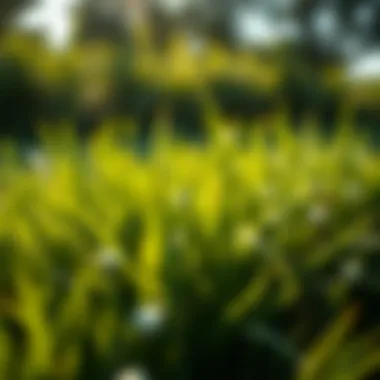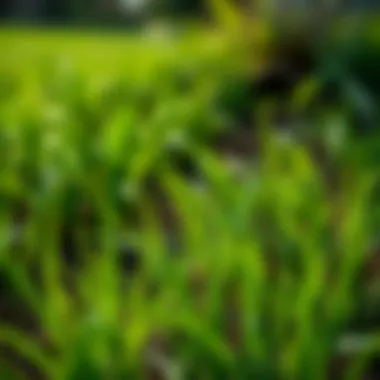Factors Affecting Bermuda Grass Greening Process


Intro
Bermuda grass is a favorite turf option for many homeowners and agricultural specialists alike, thanks to its robust nature and appealing green aesthetics. However, understanding the nuances of its growth, particularly the green-up period after dormancy, can be a real game changer.
During the colder months, Bermuda grass goes through a state of dormancy, almost like taking a long nap. This period can be concerning for lawn enthusiasts, but it’s crucial for the grass's health. When spring rolls around, certain factors come into play to coax the grass out of its slumber. In this article, we will dissect these influences, offering a broad understanding of the conditions and practices essential for fostering that vibrant green we all crave.
Key Concepts and Terminology
To fully grasp the concept of the green-up period, it’s imperative to understand some key terms associated with Bermuda grass care:
- Dormancy: This is when Bermuda grass slows down its growth due to low temperatures, conserving energy. It's akin to hibernation.
- Greening-up: The process where Bermuda grass resumes growth and turns lush green after dormancy.
- Physiological Response: Refers to how the grass reacts to environmental changes, such as temperature and moisture levels.
Definition of Terms
Before delving into the factors that influence the green-up process, it’s essential to clarify some terms that will be frequently used in this discourse.
- Soil Temperature: Bermuda grass typically begins to green up when soil temperatures reach around 65°F. This warmth signals the grass that it’s time to awaken.
- Photosynthesis: Once temperatures rise, Bermuda grass starts producing energy through sunlight, leading to growth.
Overview of Relevant Practices
Taking proper steps during the green-up period can make a significant difference:
- Soil Preparation: Testing soil health before the green-up season can ensure the necessary nutrients are present.
- Aeration: A technique that involves perforating the soil to improve air exchange, enhancing root development and overall health.
- Fertilization: Using nitrogen-rich fertilizers during the green-up phase can promote vigorous growth.
"The right steps during the critical green-up phase can mean the difference between a thriving lawn and one that struggles all season."
Current Trends and Innovations
Keeping up with the latest trends can help maximize the effectiveness of your Bermuda grass care regimen.
Latest Research and Developments
Recently, studies have shown that the timing of fertilizer application plays a crucial role in grass revival. Delaying fertilization until after the grass has shown signs of greening can result in healthier lawn development.
Emerging Technologies and Tools
Technology has introduced tools such as soil moisture sensors and temperature monitors that can help in timing your care practices more effectively. Knowing exactly when your lawn is ready for that first mowing can take the guesswork out of your lawn care routine.
Practical Applications
Understanding how to apply knowledge about the green-up period is vital for successful grass maintenance.
Step-by-Step Guides
- Monitor Soil Temperature: Use a soil thermometer to check when temperatures hit that sweet 65°F.
- Aerate and Overseed: Early spring is ideal for preparing the ground; this allows nutrients to penetrate more easily.
- Regular Watering: As growth resumes, maintaining consistent moisture is key.
Troubleshooting Common Issues
If your Bermuda grass is sluggish to green up, check for:
- Too much shade: Make sure your lawn receives adequate sunlight, which is vital for photosynthesis.
- Poor soil health: A soil test can reveal pH imbalances or nutrient deficiencies that may hinder growth.
- Improper mowing: Cutting the grass too short can stress it out, leading to slower recovery.
Prelude to Bermuda Grass
Bermuda grass, known scientifically as Cynodon dactylon, has carved a niche for itself in the hearts of those looking to cultivate vibrant lawns, athletic fields, and golf courses. This article starts with an introduction to this resilient turf, offering an understanding of what sets it apart in the landscaping world. The importance of knowing about Bermuda grass extends not just to its aesthetics but also to practical cultivation and maintenance aspects that are vital for success.
Characteristics and Popularity
Bermuda grass is celebrated for its durability and adaptability. It thrives in warm, sunny climates and is particularly well-suited to areas that experience both heat and drought. Its fine texture and deep green color make it an appealing choice for homeowners and landscapers alike. The grass has a tendency to establish quickly from both seeds and sod, making it a go-to option for creating lush, green spaces in a short amount of time.


The popularity of Bermuda grass is also rooted in its resistance to pests and diseases. Compared to other grass types, it can perform well even under stress, recovering quickly from wear and tear, whether from foot traffic or harsh environmental conditions. This resilience makes it a favorite among sports turf managers and homeowners who value a lawn that can take a beating and still bounce back.
Additionally, Bermuda grass is often favored for its ability to sequester carbon, indirectly contributing to a healthier environment. Its extensive root system aids in soil stability and erosion control. From a practical perspective, these characteristics call for specific management practices that ensure optimal health, especially during its green-up period.
Ideal Growing Conditions
Understanding the ideal growing conditions for Bermuda grass is crucial for anyone looking to cultivate this hearty turf. It typically prefers warm temperatures, ideally between 75°F and 95°F. In these conditions, Bermuda grass exhibits vigorous growth and a deep color that is aesthetically pleasing.
Soil health also plays a significant role in the growth and sustainability of Bermuda grass. Well-draining, sandy loam soils are often recommended, as they facilitate root expansion and prevent waterlogging. Adding organic matter to improve soil structure enhances drainage and provides essential nutrients.
Moreover, while Bermuda grass enjoys sunlight, it's also vital to consider its moisture requirements. An ideal configuration includes a balance between adequate irrigation and natural rainfall, ensuring the grass receives just enough water without becoming oversaturated.
By grasping these fundamental properties and needs of Bermuda grass, one can not only optimize its growth during the green-up period but also enjoy a resilient lawn throughout the warm months. Therefore, a thorough understanding of these elements serves as a foundation for sustainable lawn management practices that benefit both aesthetics and environmental health.
Understanding Dormancy in Bermuda Grass
Understanding dormancy in Bermuda grass is crucial for anyone aiming to maintain a lush, healthy lawn. This phase, while it may seem like the grass is taking a break, is actually a vital process that ensures its survival during harsh conditions. Dormancy affects the grass’s growth cycle, and recognizing the signs can help you provide better care tailored to these specific needs. When we delve into the reasons behind dormancy, we uncover how temperature, moisture, and nutrient availability come into play. These factors not only influence when the grass sleeps but also signal when it’s time to wake it up.
What Triggers Dormancy?
Dormancy in Bermuda grass is primarily triggered by external environmental factors. When the temperatures drop below a certain threshold—usually around 50°F or 10°C—this turfgrass starts to curl up and turn brown. This reaction is its way of conserving energy and protecting itself from cold stress. Likewise, drought conditions can send Bermuda grass into dormancy as well, to avoid dying off completely when water is scarce.
- Temperature Changes: As temps cool, especially during winter, Bermuda grass registers these shifts and initiates dormancy.
- Moisture Levels: Prolonged dry spells will promote dormancy. The grass simply shuts down as a smart survival tactic.
- Nutrient Deficiency: Lack of essential nitrogen or other nutrients can also be a trigger. Poor soil fertility compels the grass to halt growth until conditions improve.
Being aware of these triggers allows caretakers to better plan their maintenance routines, using it to their advantage when transitioning into the growing season again.
Effects of Temperature on Dormancy Patterns
Temperature plays a significant role in determining the exact timing and duration of Bermuda grass dormancy. The correlation between temperature and dormancy can be likened to cooking—too hot can burn your dish (or in this case, the grass), while too cold can leave it raw. Here are some key points:
- Frost Impact: Once frost settles in, the grass will begin its dormancy process—most growth ceases, and the vibrant green fades.
- Warm-Up Periods: Interestingly, if a warm snap occurs during winter, Bermuda grass might temporarily break dormancy. It’s like a tease—a brief spell of growth before returning to its dormant state when the cold returns.
- Optimal Growth Temperatures: Generally, Bermuda grass thrives when soil temperatures hit around 65°F to 70°F. This is when it gets back to business, ramping up growth after its dormant phase.
Understanding how temperature fluctuations affect this turf can prepare you better for the upcoming growing season. As the temperatures warm, implementing practices that support this transition is vital.
When Does Bermuda Grass Turn Green?
Understanding when Bermuda grass turns green is essential for anyone looking to maintain a lush and vibrant lawn. This process, known as the green-up period, marks the end of dormancy and the beginning of active growth. For homeowners and farmers alike, knowing the timeline of this transformation can facilitate better lawn care and overall maintenance strategies.
The significance of recognizing the green-up moment lies in planning your seasonal maintenance. Proper timing can mean the difference between a thriving lawn and a struggle against weeds and pests. As temperatures rise, Bermuda grass awakens from its winter sleep, prompting a flurry of biological activity that leads to visible greenery. This gives owners the chance to prepare their lawns for the growing season ahead, adjusting care routines based on when their grass is likely to start reviving.
Spring Awakening Factors
Bermuda grass begins its resurgence in spring, reacting mainly to changing temperature and sunlight conditions. Several factors play a crucial role in kickstarting this green-up process.
- Soil Temperature: One of the most critical aspects for Bermuda grass to come out of dormancy is the soil temperature, which should ideally reach around 65°F (18°C). At this threshold, the roots begin to wake up, stimulating growth above the surface. Soil testing can provide insights into temperature, giving you a clue when grass will start greening.
- Day Length: Stabilizing day length also has a role to play. As the days get longer, plants receive more light, signaling them to commence their growth. Typical around late March to mid-April, regions with significant sunlight will see quicker green-up.
- Moisture Levels: Adequate moisture is paramount. Too much or too little can deter the green-up period. Grass needs consistent watering to support its nascent growth. In both over-watering and drought situations, the grass might display delayed greening, leading to a less attractive lawn.
In sum, weather patterns and local climate conditions can all serve as indicators of when your Bermuda grass might turn a lush green.
Typical Timelines for Green-Up
Once the conditions align, the timeline for Bermuda grass to leaf out can vary by region and its specific micro-conditions. On average, Bermuda grass typically starts to show signs of life around 7 to 14 days after favorable temperatures and sunlight conditions have been reached.
- Southern States: Regions such as Florida and Texas might see the first green blades as early as early March. Warmer climates enable a quicker transition from dormancy.
- Transition Zones: Locations like Georgia or South Carolina will often experience initial growth beginning from mid-March to early April. Changes in temperature directly influence the onset of green.
- Northern Regions: For states like Kentucky, it is not until late April or even early May that Bermuda grass starts to recover from dormancy. Here, cooler temperatures keep grass in a state of slower growth longer than in warmer climates.
In all these cases, be mindful that unexpected cold snaps can briefly halt this development. The challenge is to stay observant and respond proactively to assist the Bermuda grass through proper care, ensuring it has the best chance to thrive after dormancy.
"Understanding the timeline of Bermuda grass growth offers not only a roadmap for maintenance but also peace of mind for gardeners who invest in their landscapes every year."
Keeping tabs on these indicators can provide a clearer understanding of your grass's lifecycle and help you achieve that lush green aesthetic that many strive for.


For more guidance on lawn care practices, check out useful resources on Wikipedia, Britannica, and community insights on Reddit.
Impact of Soil Conditions
The green-up period of Bermuda grass is profoundly influenced by various soil conditions. Understanding how soil health affects growth is fundamental for those looking to achieve a robust and vibrant lawn. Factors such as soil temperature and nutrient availability play pivotal roles in determining both the timing and success of Bermuda grass's transition from dormancy to lush greenery. It’s not just about tossing some seeds and hoping for the best; it requires a strategic approach, especially when ensuring that the soil is in prime condition to support growth.
Soil Temperature Requirements
Bermuda grass is considered warm-season grass, meaning it thrives when temperatures begin to rise. But what exactly does this mean for soil temperature? Generally, Bermuda grass starts to awaken when soil temperatures consistently reach around 65°F (18°C). When soil remains cooler, the grass tends to stay dormant, much like a heavy blanket that refuses to budge.
Having the right soil temperature isn’t just an arbitrary number. It signals the plant that it's time to break out of its winter slumber. Farmers should pay attention to the readings on their soil thermometer in early spring.
Note that for optimal growth, the soil temperature needs to remain above 70°F (21°C) ideally, as this promotes quick green-up and improves the overall vigor of the grass. This warmth helps activate various biochemical processes within the grass that encourage growth. Varieties of Bermuda grass may respond differently to temperature fluctuations, so it can be beneficial to be aware of this variability.
"If the soil's too cold, you're essentially drawing a blank on the growth chart."
Nutrient Availability and Its Role
Now let's talk about nutrients – the lifeblood of your Bermuda grass. Just as you wouldn't run your car on empty, your grass needs the right nutrients to make that green-up transition successful. Certain nutrients, specifically nitrogen, phosphorus, and potassium, are particularly crucial during the greening process.
- Nitrogen is vital for leaf growth and overall plant health. It encourages lush, green foliage, which is particularly important as the grass wakes up.
- Phosphorus plays a key role in root development, helping the grass establish a strong foundation that can access moisture and other nutrients.
- Potassium strengthens the plant's cellular structures, increasing its resilience against pests and diseases.
To ensure that these nutrients are available, conducting a soil test is essential. Many local agricultural extensions provide testing services. Additionally, using organic fertilizers can enhance soil health by improving its structure and increasing nutrient retention.
In summary, understanding how soil temperature and nutrient availability impact Bermuda grass helps cultivate a thriving lawn that bounces back each spring. As you care for your turf, always keep an eye on these critical soil conditions to facilitate a successful and vibrant green-up period.
Optimizing Care for Bermuda Grass
Caring for Bermuda grass during its green-up period is crucial for achieving vibrant, lush turf that can withstand wear and tear. The significance of optimizing care lies in creating the ideal environment for healthy grass resurgence after dormancy. Proper practices ensure that the grass can thrive, resist diseases, and tackle competitive weeds. It's not just about making it look good; it’s about promoting long-term health and sustainability of the turf.
Watering Practices During Green-Up
Watering is a vital component in the green-up process for Bermuda grass. As temperatures rise and the grass starts to awaken from dormancy, it requires adequate moisture to stimulate growth. A common mistake is assuming that grass will need less water during its transition. Instead, water wisely to promote deeper root development which is essential for resilience.
- Frequency: During the early stages of greening, watering every few days might be necessary, especially if rainfall is scarce. Aim for about 1 to 1.5 inches of water per week.
- Timing: Morning is the best time to water. This allows the grass to absorb moisture before the heat of the day evaporates it away. Plus, it reduces the risk of fungal diseases that can arise from wet blades at night.
- Method: Use a sprinkler or irrigation system that distributes water evenly, avoiding puddles or dry spots. Consider using a moisture meter to gauge soil conditions more accurately.
Adopting these watering practices helps Bermuda grass to reap the benefits of soil nutrients more effectively, paving the way for a strong and enduring lawn.
Fertilization Strategies for Enhanced Growth
Fertilization plays a significant role in revitalizing Bermuda grass during its green-up phase. A well-timed fertilization regimen can rev up the growth engines of your turf as it reclaims its vibrant green color. Here are some strategies to consider:
- Timing: Fertilize the grass when soil temperatures consistently reach around 65°F, suggesting that the grass is waking up. Apply a starter fertilizer that is high in phosphorus to encourage root establishment.
- Type of Fertilizer: Use slow-release nitrogen fertilizers to provide a continuous supply of nutrients over time. This type of fertilizer minimizes the risk of burning the grass while ensuring steady growth.
- Application Method: Use a drop spreader for an even distribution of fertilizer. Following the manufacturer's instructions regarding coverage rates will help avoid any negative impact from over-fertilizing.
"The right fertilization strategy sets the stage for lush green growth, enhancing the overall health of your Bermuda grass."
Mowing Techniques to Promote Health
Mowing is not just about aesthetics; it plays a critical role in the health and growth of Bermuda grass. Proper mowing techniques during the green-up period can bolster the strength of your turf:
- Height of Cut: Mow at a height of about 1 to 2 inches, removing no more than one-third of the leaf blade per mowing session. Taller grass shades the soil, reducing evaporation and encouraging deeper root systems.
- Frequency: Mow frequently as the grass grows; this encourages lateral growth and thickens the turf, making it less susceptible to disease and pests.
- Sharp Blades: Always mow with sharp blades. Dull blades can tear the grass, making it more prone to stress and disease.
By integrating these mowing techniques, you ensure that your Bermuda grass remains healthy, well-structured, and visually appealing throughout its growth cycle.
Environmental Factors Influencing Growth
Understanding the environmental factors that influence the greening process of Bermuda grass is essential for any landowner or turf enthusiast. These elements not only affect the grass’s health but also dictate its overall appearance and resilience against pests and diseases. Ultimately, a thorough knowledge of these factors allows for better management practices, ensuring that Bermuda grass thrives when it comes out of dormancy.
Key aspects to consider include humidity and moisture levels, as well as sunlight requirements. All of these components interact with one another and have a crucial role in how effectively Bermuda grass undergoes its green-up period. Without adequate attention to these environmental factors, even the best care strategies might go to waste.


Humidity and Moisture Levels
Humidity and moisture levels are paramount to successful growth during the green-up phase of Bermuda grass. This grass type enjoys a warm, humid climate, which allows it to flourish. When humidity is low, the grass may struggle to absorb sufficient moisture from the soil, leading to stunted growth or unhealthy turf. Conversely, excessive humidity can create a different set of challenges, fostering environments conducive to disease.
To maintain optimal growth, here are some considerations:
- Consistent Moisture: Regularly watering your Bermuda grass ensures that the soil remains adequately moist. It's vital not to let the grass dry out completely, as this can hinder the greening process.
- Avoid Waterlogging: Poor drainage can lead to waterlogged conditions, which may suffocate roots and promote fungal diseases. The right balance is key.
- Use Mulching: Applying mulch can help retain soil moisture while preventing evaporation, which is particularly beneficial in dry climates.
It's worth noting that Bermuda grass has a deep root system, enabling it to tap into moisture reserves during drier periods. However, during the spring green-up, surface moisture is critical to initiate this process.
Sunlight Requirements for Optimal Growth
Bermuda grass is a sun-loving plant that thrives best in environments with full sunlight. This means it needs at least six to eight hours of direct sunlight per day to maximize photosynthesis, resulting in a healthy green lawn. Sunlight not only aids in the greening process but also enhances overall vigor and resilience.
Here are some guidelines for managing sunlight exposure for Bermuda grass:
- Select the Right Location: When planting Bermuda grass, choose a sunny spot. Areas shaded by trees or structures may not promote healthy growth.
- Trim Surrounding Vegetation: If nearby trees or shrubs cast too much shadow, consider pruning them to increase light exposure.
- Assess Sunlight Throughout the Year: Different seasons can shift how much sunlight an area receives. Plan accordingly to ensure optimal growing conditions during the crucial green-up phase.
"Adequate sunlight is like fuel for Bermuda grass. Without it, the plant finds it hard to sustain itself, let alone flourish."
For further exploration on the optimal growth conditions of Bermuda grass, resources such as Wikipedia and Britannica can provide additional insights.
Common Issues During the Greening Process
Understanding the challenges that Bermuda grass may face during its green-up phase is essential for any turf enthusiast or agricultural farmer. While these grass varieties thrive in favorable conditions, there are common issues that can impede their recovery and affect the overall health of the lawn. Addressing these concerns early on can make a monumental difference in nurturing a robust and lush Bermuda turf.
Pest Infestations
One of the most pressing problems that can arise during the greening process is pest infestations. Various insects can take a liking to Bermuda grass as it starts to emerge from dormancy. Grubs, for example, are notorious for wreaking havoc on root systems. They feed on the roots, which can severely inhibit growth and lead to dead patches in your once-vibrant lawn.
In addition to grubs, chinch bugs and armyworms are often found during this transition. Chinch bugs, in particular, can cause significant damage in warm conditions. Affected turf may appear to have brown patches even as the green-up begins. Thus, keeping a vigilant eye on your grass as it starts to revive is crucial.
Some effective strategies for managing these pests include:
- Regular Inspections: Regularly check your lawn for signs of insect damage or activity. Look for punctured grass blades or telltale signs of chomping.
- Natural Predators: Encourage beneficial insects, like ladybugs, which can keep pest populations in check.
- Insecticides: In cases of severe infestation, appropriate insecticides may be necessary, but make sure to follow application instructions carefully.
"An ounce of prevention is worth a pound of cure." Taking early action can save you time and effort in the long run.
Disease Management
In addition to pests, diseases pose another threat during Bermuda grass's recuperation phase. Several fungal and bacterial diseases can crop up, especially if conditions are not optimal. For instance, large patch fungus often strikes as temperatures warm and can create circular brown spots within a grassy expanse. This fungal infection is more prevalent in humid conditions, making it imperative to watch for moisture management.
To effectively manage diseases, consider the following measures:
- Proper Watering: Overwatering can predispose your lawn to diseases. Water early in the day to allow moisture to evaporate by evening, reducing the likelihood of fungal outbreaks.
- Aeration: Aerating the lawn helps improve air circulation and drainage, diminishing moisture retention in the grass that can encourage disease development.
- Fungicides: In cases where diseases escalate, fungicides can help control the spread. However, timing and the method of application are key aspects to consider for effectiveness.
Participating in routine maintenance and observing changes closely will aid in identifying and tackling these issues before they spiral out of control. Keeping your Bermuda grass healthy during its greening process includes recognizing potential setbacks and, when necessary, reaching for solutions promptly.
Culmination
As we wrap up our comprehensive look at Bermuda grass and its green-up period, it’s clear that understanding this process is pivotal for anyone involved in turf management. The greening of Bermuda grass is not just about watching lawns transform; it’s a detailed dance between environmental factors, proper maintenance, and biological responses. The timing of this transformation can significantly influence overall lawn health and aesthetics, leading to operational efficiencies that can directly impact farmers and turf enthusiasts alike.
Key Takeaways on Bermuda Grass Maintenance
- Know the Growth Cycle: Recognizing the specific growth and dormancy cycles of Bermuda grass provides a framework for effective lawn care. Understanding these cycles allows for timely interventions and adjustments in maintenance practices.
- Monitor Soil Quality: Healthy soil is fundamental. Testing soil pH, nutrient levels, and moisture can lead to informed decisions regarding fertilization and watering. This ensures that the grass receives what it needs to thrive as it wakes from dormancy.
- Adapt to Weather Changes: Weather plays a crucial role in greening. Observing temperature and humidity levels will guide your watering and mowing practices, helping to establish a strong resurgence.
- Stay Vigilant with Pests and Diseases: With the return of growth comes the risk of pests and diseases. Regularly inspecting your lawn can prevent infestations from becoming damaging.
"An ounce of prevention is worth a pound of cure."
Future Considerations for Turf Management
Looking ahead, one must consider several factors that could shape the approach to Bermuda grass management in the future. Here are some key aspects:
- Climate Adaptation: As climates shift, understanding how Bermuda grass adapts will be critical. Researching how to maintain its vigor in varying conditions will be part of staying one step ahead.
- Innovative Products: Stay informed about new fertilizers and pest management solutions that enhance growth while minimizing environmental impact. Such products can often provide a quicker, healthier green-up period.
- Sustainable Practices: Emphasizing sustainable practices, such as using native plants in combination with Bermuda grass, can benefit both the landscape and local ecosystems.
- Ongoing Education: The field of turf management is always evolving. Engaging with new studies and joining forums can foster better practices and community support. Platforms like reddit.com can be helpful in connecting with fellow enthusiasts.
In summary, the knowledge and strategic actions outlined in this article serve as a foundation for maintaining and enhancing the health and beauty of Bermuda grass. By prioritizing informed and proactive measures, one can achieve a thriving green space that performs beautifully through all seasons.







